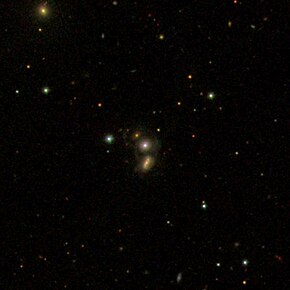| IC 1166 | |
|---|---|
 Sloan Digital Sky Survey image of galaxy pair IC 1166 | |
| Observation data (J2000 epoch) | |
| Constellation | Corona Borealis |
| Right ascension | 16h 02m 08.90s |
| Declination | +26d 19m 38.0s |
| Redshift | 0.072080 |
| Heliocentric radial velocity | 20,818 km/s |
| Distance | 977 Mly (299.54 Mpc) |
| Apparent magnitude (V) | 16.77 and 19.08 |
| Surface brightness | 23 and 23.4 mag/arcsec |
| Characteristics | |
| Type | E and SBb |
| Size | 110,000 ly and 160,000 ly |
| Notable features | Interacting galaxy and Seyfert galaxy |
| Other designations | |
| IC 1166 NED01: PGC 56771, Mrk 867, 2MASX J16020888+2619456, SDSS J160208.91+261945.5, NVSS J160208+261942, KUG 1600+264, CGCG 137-018, IRAS 16000+2628, PGC 1772024, Mrk 867N IC 1166 NED02: PGC 1771884, UZC J160208.9+261929, 2MASX J16020881+2619316, SDSS J160208.82+261931.1, Mrk 867S | |
IC 1166 are a pair of galaxies in the Corona Borealis constellation[1] comprising IC 1166 NED01[2] and IC 1166 NED02.[3] They are located 977 million light-years from the Solar System[4] and were discovered on July 28, 1892, by Stephane Javelle.[5]
- ^ Astronomy, Go. "IC 1166 | galaxy pair in Corona Borealis | IC List | GO ASTRONOMY". Go-Astronomy.com. Retrieved 2024-04-30.
- ^ "IC 1166 NED01 - Elliptical Galaxy in Corona Borealis | TheSkyLive.com". theskylive.com. Retrieved 2024-04-30.
- ^ "IC 1166 NED02 - Barred Spiral Galaxy in Corona Borealis | TheSkyLive.com". theskylive.com. Retrieved 2024-04-30.
- ^ "Your NED Search Results". ned.ipac.caltech.edu. Retrieved 2024-04-30.
- ^ "Index Catalog Objects: IC 1150 - 1199". cseligman.com. Retrieved 2024-04-30.